Google Nexus 5 Review
by Brian Klug on December 5, 2013 8:00 AM EST- Posted in
- Smartphones
- LG
- Android
- Mobile
- Snapdragon 800
- Android 4.4
- Nexus 5
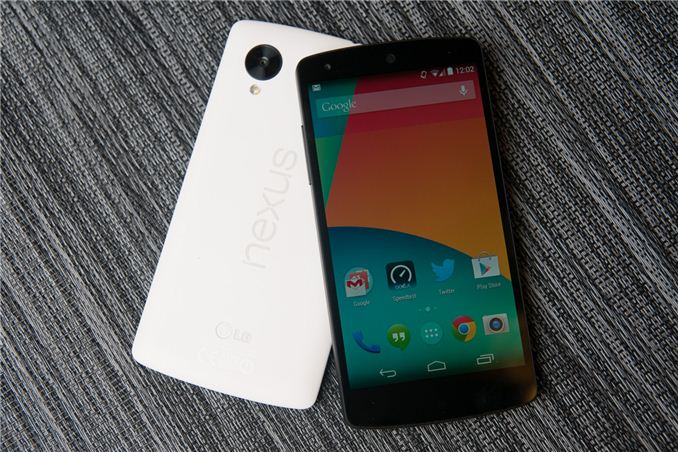
Each year, Google picks a silicon vendor, a hardware partner, and releases a new version of Android running on top of them. The result is a Nexus phone, and for five iterations now that process has repeated, resulting in a smartphone that’s the purest expression of Google’s vision for its mobile platform. Today we’re looking at the Nexus 5.
Nexus 5, as its name makes obvious, is the latest generation of Google’s line of Nexus smartphones, and also is topped by a 5-inch display. While the Nexus program originally started only for smartphones, we’ve seen Google since extend the program to include a 7-inch and 10-inch tablet form factor, as well as a line of accessories. In recent years, we’ve seen Nexus go from being part enthusiast curiosity and development device, to a brand tailored for consumers looking for the latest and greatest the Android platform has to offer at a killer price.
Last generation we saw the Nexus 4, a device that was essentially an LG Optimus G for T-Mobile in different clothing and priced at a competitive price, yet still included the latest and greatest silicon from Qualcomm with APQ8064 (S4 Pro). For Nexus 5, Google has once again gone with hardware partner LG and silicon vendor Qualcomm, this time with a phone that’s somewhat analogous to the LG G2 (but not exactly the same platform) and using the latest and greatest MSM8974 (Snapdragon 800) silicon.
Let’s start with the hardware, since that’s the normal flow for a review. The Nexus 4 bore a lot of superficial similarities to the Optimus G, including a glass back with laser etched design below its surface, the same display, banding, and materials. The Nexus 5 on the other hand doesn’t bear any similarities to the G2, with its buttons on the back, narrow bezel, rounded backside, and glossy plastic. Instead, the Nexus 5’s design borrows much of its industrial design language from the Nexus 7 (2013), with the slightly rounded top and bottom, landscape “nexus” logo on the rear, and large radius curves all around the side. The Nexus 5 and 7 share almost the same shape and profile, and in the case of the black Nexus 5, same rubberized soft touch material on the back and sides. If you scaled down the Nexus 7 design you’d get something which is awfully close to the Nexus 5.
The result is a two-device family that feels like it was made by the same company, and it’s really the first time Google has aligned its industrial design in such a sweeping fashion, in this case even across two different hardware partners. I guess you could make the argument that with the exception of the Nexus 10, Google has eliminated any industrial design fragmentation and finally crafted some hardware design language that it owns for itself.
Google sampled us first a black Nexus 5, and later a white Nexus 5 at my request so I could check out the material differences I saw some discussion about. It’s true that there are some differences between the two devices. For starters, the white device has a backside which eschews the soft touch material, instead giving the polymer-backed device a rougher, textured feeling. The absence of soft touch continues to the edge, which is glossy black plastic instead of the rubberized material, and comes with protective plastic installed over it by default. On the front the only visible difference between white and black is a white colored earpiece, the rest of the bezel around the display is still black.
I’m reminded of the split between the white and black Note 3 with the Nexus 5, which also only includes rubberized material on the black model. I find myself preferring the feeling of the white model instead, but it’s really just a story of personal taste. No doubt the absence of soft touch on the white material is to prevent staining from hand oils or other dyes as the device ages. I don’t find that the absence of soft touch on the white model makes it any more difficult to hold or grip onto, the negative-angled bezel really does help the Nexus 5 fit into the hand securely.
Although the Nexus 5 is a close cousin, it doesn’t adopt the button arrangement from the G2, instead locating the volume and standby buttons in a normal place. Volume rocker ends up on the left, power on the right side.
Likewise earpiece is on top and microUSB is at the bottom of the device. What’s unique about the Nexus 5 buttons is the material of those buttons – they’re ceramic, not polycarbonate. The result is that they’re sharp and instantly locatable with the brush of a finger, it’s a subtle thing that does feel different. The only complaint I have is that they do seem to rattle slightly inside their cutouts. I can affirm that the white model seems to have less rattle, but I’m not entirely sure how much of that is intrinsic to the color difference and absence of soft touch.
Also on the back is the Nexus 5’s oversized camera cutout, which is slightly raised from the surface around it. It’s fair to say that the Nexus 5 does have a camera bump, something that’s not going away soon in all but the most iconic devices. When I first saw the oversized ring, I assumed it was just a design motif, and others later speculated it was for a line of magnetically-attachable add on lenses. To date none of those have materialized, and upon further consideration having magnets next to the VCM (voice coil motor) electromagnetic focus and OIS mechanism could complicate things. In any case, at present the oversized ring around the camera aperture is a unique design point rather than something which serves a function.
The only real negative about the camera cutout is that dust seems to be able to get into the crack surrounding it and the cover glass. It’s something unfortunate about the Nexus 5’s design in general – there are cracks that show dirt quickly, for example the backside has a seam around the edge where dust seems to intrude. It obviously doesn’t change the Nexus 5’s function, but immediately starts looking dirty on the black model, and part of why given both side by side I prefer the white one.
I think pragmatic describes the Nexus 5 design quite well, since honestly the design doesn’t try to be flashy just for the sake of differentiation or make any crazy materials choices on the outside. There are subtle design features which definitely are appreciated, however, like the negative angle to the edge which makes the device easy to grip, those ceramic buttons, and the continuity of design language from the Nexus 7 of course. Materials are a big differentiator between devices right now, and again the Nexus 5 is relatively pragmatic with its choice of polymer, but does deserve kudos for not going with the slick, glossy-surfaced material still preferred by Korean handset makers.
The Nexus 5 feels well made and precision crafted, but I can’t shake the feeling that Nexus 4 felt more like a standout design of its own. The Nexus 5 seems a lot more, well, traditional, without the rounded-glass edges, chrome ring, or pattern below the glass on the back (which I still maintain contained some kind of encoded message). The reality is that Google made a lot of decisions with Nexus to optimize for cost, and that the Nexus 5’s design is actually quite differentiated given the price.
The Nexus 5 adds a lot over its predecessor – larger 1080p display, newer silicon, 802.11ac, better camera with OIS, and of course LTE connectivity, all while getting minimally more expensive than its predecessor. It’s almost unnecessary to say that the Nexus 5 is obviously the best Nexus phone yet.
| Physical Comparison | ||||
| LG G2 | Samsung Galaxy Nexus (GSM/UMTS) | LG Nexus 4 | LG Nexus 5 | |
| Height | 138.5 mm | 135.5 mm | 133.9 mm | 137.84 mm |
| Width | 70.9 mm | 67.94 mm | 68.7 mm | 69.17 mm |
| Depth | 9.14 mm | 8.94 mm | 9.1 mm | 8.59 mm |
| Weight | 143 g | 135 g | 139 g | 130 g |
| CPU |
2.26 GHz MSM8974 (Quad Core Krait 400) |
1.2 GHz OMAP 4460 (Dual Core Cortex A9) | 1.5 GHz APQ8064 (Quad Core Krait) |
2.26 GHz MSM8974 (Quad Core Krait 400) |
| GPU | Adreno 330 | PowerVR SGX 540 @ 304 MHz | Adreno 320 | Adreno 330 |
| RAM | 2 GB LPDDR3 | 1 GB LPDDR2 | 2 GB LPDDR2 | 2 GB LPDDR3 |
| NAND | 16/32 GB NAND | 16/32 GB NAND | 8/16 GB NAND | 16/32 GB NAND |
| Camera | 13 MP with OIS and Flash (Rear Facing) 2.1 MP Full HD (Front Facing) | 5 MP with AF/LED Flash, 1080p30 video recording, 1.3 MP front facing | 8 MP with AF/LED Flash, 1.3 MP front facing | 8 MP with OIS, AF, LED flash, 1.3 MP front facing |
| Screen | 5.2-inch 1920x1080 Full HD IPS LCD | 4.65" 1280x720 SAMOLED HD | 4.7" 1280x768 HD IPS+ LCD | 4.95" 1920x1080 HD IPS LCD |
| Battery | Internal 11.4 Whr | Removable 6.48 Whr | Internal 8.0 Whr | Internal 8.74 Whr |
Google also sent over one of the Nexus 5 bumper cases, which really isn’t so much bumper as it is, well, all around case. The Nexus 4 had bumpers that wrapped around the edge, but left the glass back exposed, much like the iPhone 4/4S era bumpers.
Nexus 5’s bumper case covers up everything but the oversized camera aperture on the back. The red one I got doesn’t seem to be silicone but some other thermoplastic.
At $35 it’s a bit on the pricey side, but it does fit the device nicely and get the job done with some cool neon colors that spice up the Nexus 5.


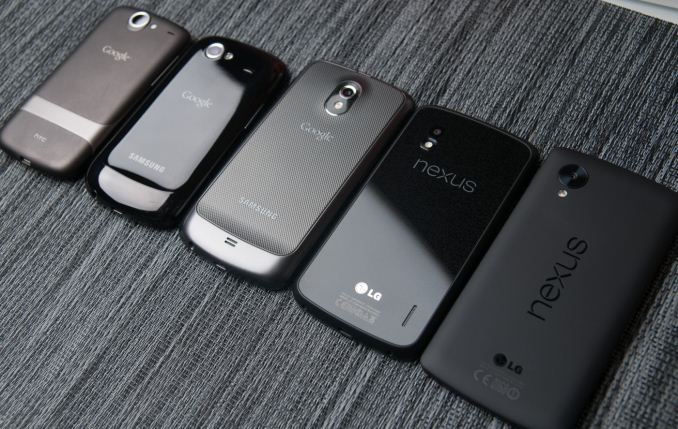
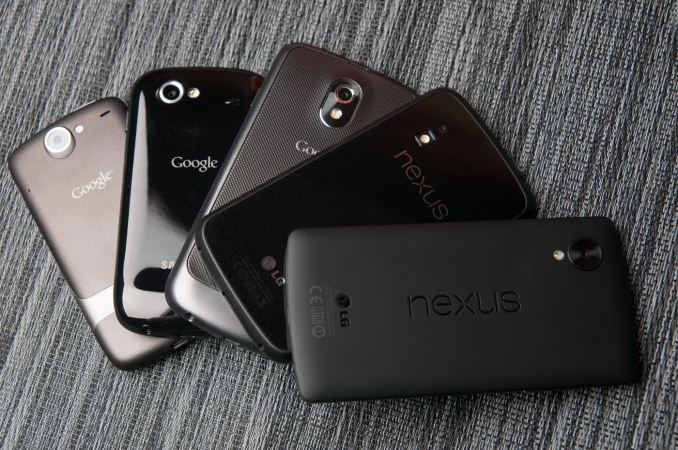
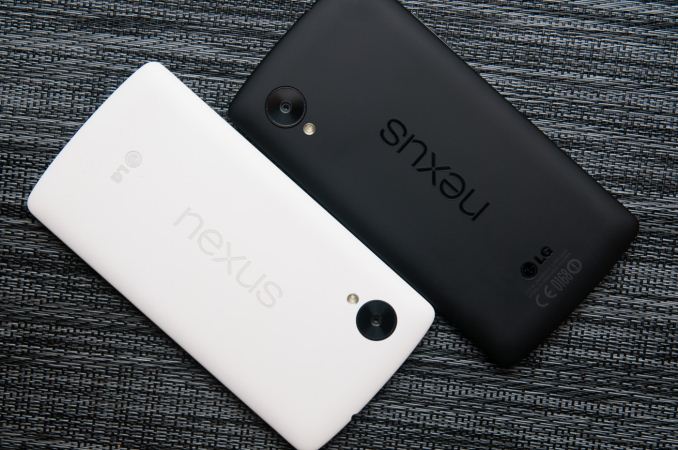
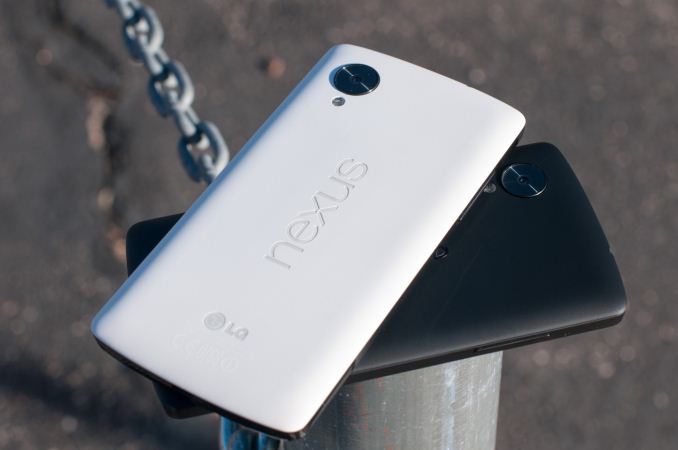
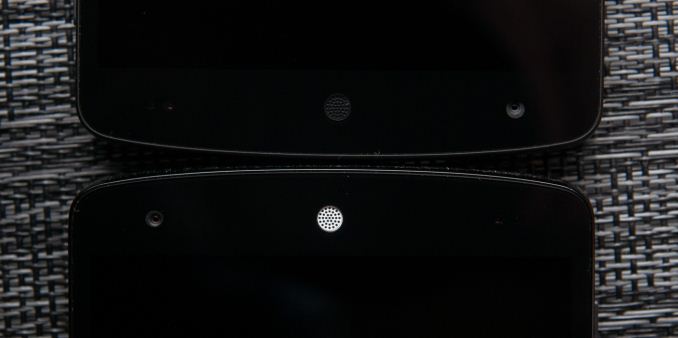
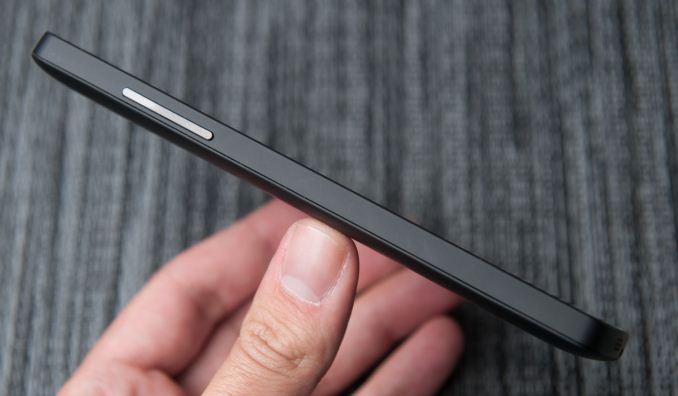
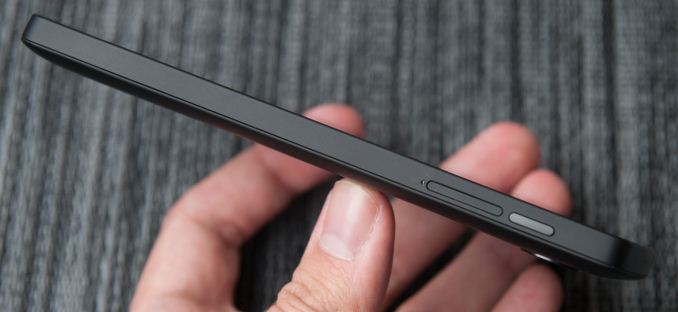








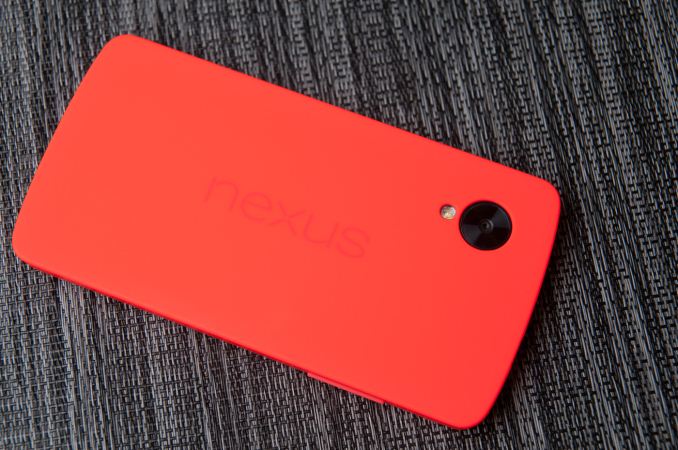
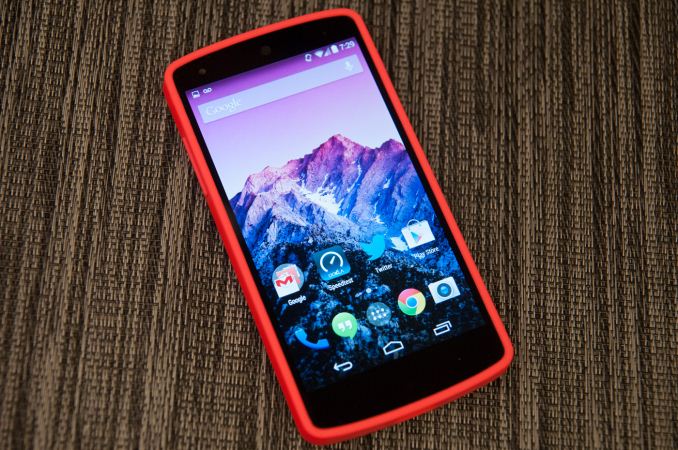








231 Comments
View All Comments
rwei - Thursday, December 5, 2013 - link
>nobody has still been able to merge the two together the same way WebOS did with the Palm PreWP does a good enough job interleaving and integrating the two that I'm almost completely agnostic over whether I use SMS, Facebook or MSN/Skype, and switch between them seamlessly based on my iOS/Android recipients' preferences.
PsychoPif - Thursday, December 5, 2013 - link
I really love AnandTech, but I find the fact that they act like Windows Phones does'nt exist quite disturbing.I see 18 device on the battery chart, but not one runs WP8.
kyuu - Thursday, December 5, 2013 - link
Brian Klug seems to have a personal beef with Windows Phone and, apparently, refuses to review them.hrrmph - Thursday, December 5, 2013 - link
I have one sitting here in front of me (a Samsung ATIV-S that I bought on the cheap to play with).So let me point out that out of the 4 devices (3 operating systems and as many manufacturers) that I use, it is the only one that cannot handle my complete collection of music files (it chokes on FLAC files).
So after 20 years of making about 40 billion dollars a year, Microsoft cannot bring themselves to support the leading open standard for high quality 24-bit loss-less audio files?
munim - Friday, December 6, 2013 - link
Probably because it's useless to have such high fidelity support on a mobile device that you'll be using outside of a studio.Impulses - Friday, December 6, 2013 - link
Yeah, I'm surprised there's so many mentions of FLAC thru the comments... It's almost ironic, I really hope none of the people pinning for FLAC support are the same ones complaining about removable storage!My entire CD collection is ripped to FLAC, it just makes the most sense got archival purposes, I wish more mainstream music was available in lossless formats just out of principle... However it's pretty pointless to be dragging FLAC files around on a phone.
You're not gonna be able to tell the difference vs properly encoded MP3s, even if you're traveling with $300+ worth of DAC/amp equipment and $500+ reference grade headphones or IEM (much less the kinda headphones most people use, never mind the line out or Bluetooth which would pose the weakest link in the chain).
Do a proper blind test, then try to rationalize why FLAC support is so important... Considering it takes no time at all to convert a big library and it's gonna take up a fraction of the space your FLAC library already does (I keep a discrete MP3 library on the PC just to mak esyncs quicker, the extra space is a drop in the bucket compared to the FLAC originals anyway).
hrrmph - Saturday, December 7, 2013 - link
I'd rather spend my time searching for new music than re-encoding and maintaining more sync lists of the music that I already have. Manufacturers that bake the support into the device make life easier. Syncs of playlists "just work."64GB of NAND was $35 the other day at Amazon. 128GB is just around the corner. Is storage really all that precious so as to justify wasting time compressing it down into such a tiny space?
With storage becoming so reasonably cheap, then lossy compression becomes perhaps still useful for video, but is an utter waste of time on audio.
In fact, if tags worked properly on redbook audio CDs, I wouldn't bother compressing them at all and would just save them as .wav files.
Same thing with FLAC. If I buy it in a high-quality format, then why waste time and resources squeezing it down?
Impulses - Saturday, December 7, 2013 - link
I don't spend any time re encoding or managing separate FLAC/MP3 playlists either... Media Monkey does it all for me seamlessly and it's far easier to configure it to your particular needs than something like iTunes. Should look into it, if you're really that much of a music lover it's just foolish to use 10x more space than necessary for storing music on a phone.I bring a new CD home, open EAC to rip (simple one click process), and when I open Media Monkey later it's already set to find the new album and convert it on it's own (which doesn't even take a minute on a modern PC). When I sync it knows to only look at the MP3 library, there's truly smart playlists if for instance you wanna have a list of recently added music, etc.
My CD collection (+ online purchases) would never fit on a 64GB micro SD card encoded to FLAC, quite manageable as MP3 though. Easier to share too, or use as ringtones/alarms...
FLAC/lossless makes sense from an archival point of view, exactly because of scenarios like this. You can re-encode or edit files without taking a hit in quality... It's not a "high quality format" in the sense that you're hearing anything that you wouldn't from an MP3 though. The original mastering/editing usually has far more to do with that than the distribution format.
edi_opteron - Thursday, December 5, 2013 - link
Umm, Where is the review of Lumia 1020? Or Lumia 1520? Oh wait, the greatest tablet in the market ( forget the app count for a moment) The Lumia 2520?Nokia hasn't sent you the devices? Simple, ask one, and they'll send you with a rush! I can't believe that you guys reviewed HTC One Max or Surface 2 and didn't do the same for Nokia devices which are probably the best in their category.
Review the tablet please!!
BoneAT - Thursday, December 5, 2013 - link
Although our good friends at TheVerge suggests there's a major SW update coming in just few days improving that camera inconsistency, although not yet a new stock camera application. I look forward to you guys testing it and updating this article!